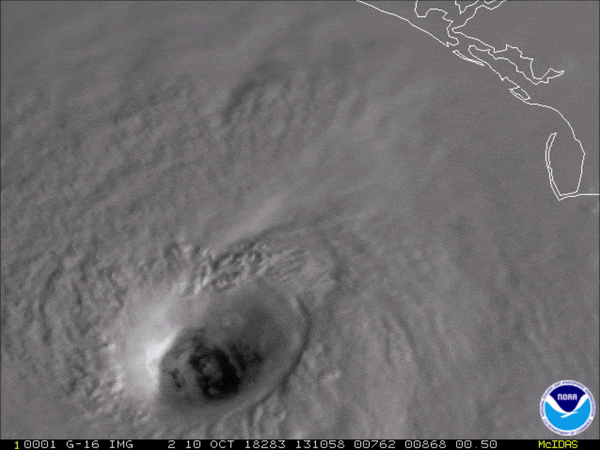Peer into Hurricane Michael's Mesmerizing Eye in This Eerie Time-Lapse Video

As Hurricane Michael, now a Category 4 storm, bears down on the Florida Panhandle, a hypnotizing, close-up view from far above Earth shows the whirling clouds circling its eye.
Time-lapse video was captured Wednesday morning (Oct. 10) by the National Oceanic and Atmospheric Administration (NOAA) satellite GOES-16 and was shared online by the Cooperative Institute for Research in the Atmosphere (CIRA), an organization conducting interdisciplinary research in the atmospheric sciences.
The footage shows 30 seconds of Michael's eye in the visible light spectrum, condensed to about 10 seconds. An eerie pocket of calm air is visible at the very center, and as the eye rotates, it creates ripples that can be seen radiating outward through the dense clouds surrounding it. [Hurricane Season 2018: How Long It Lasts and What to Expect]
Clusters of so-called "hot towers" within the eye provide additional fuel for the storm and likely contributed to Michael's swift intensification to Category 4 strength, Forbes reported. Hot towers are tall clouds that can reach heights of 9 miles (14 kilometers) and "breathe fire into the hurricane," NASA reported in 2004. These clouds gain their height from heat released by water vapor; their presence indicates that a storm will be twice as likely to intensify "within hours," according to NASA.
Though the center of Michael's eye is warm, clouds around it are very cold, with some as cold as minus 126 degrees Fahrenheit (minus 88 degrees Celsius), the National Hurricane Center (NHC) reported on Tuesday (Oct. 9).
The wall of clouds around the eye is also sparkling with lightning, Philippe Papin, an atmospheric scientist with the U.S. Naval Research Laboratory, wrote in a tweet. Papin shared an annotated satellite view, marking the locations of the lighting bursts within the storm.
Michael is traveling at about 14 mph (23 km/h) and is expected to make landfall along the Florida Panhandle early this afternoon, as a Category 4 hurricane. The storm may strengthen even further after it reaches land, the National Hurricane Center warned in a public advisory issued this morning.
Sign up for the Live Science daily newsletter now
Get the world’s most fascinating discoveries delivered straight to your inbox.
Originally published on Live Science.

Mindy Weisberger is an editor at Scholastic and a former Live Science channel editor and senior writer. She has reported on general science, covering climate change, paleontology, biology and space. Mindy studied film at Columbia University; prior to Live Science she produced, wrote and directed media for the American Museum of Natural History in New York City. Her videos about dinosaurs, astrophysics, biodiversity and evolution appear in museums and science centers worldwide, earning awards such as the CINE Golden Eagle and the Communicator Award of Excellence. Her writing has also appeared in Scientific American, The Washington Post and How It Works Magazine. Her book "Rise of the Zombie Bugs: The Surprising Science of Parasitic Mind Control" will be published in spring 2025 by Johns Hopkins University Press.










